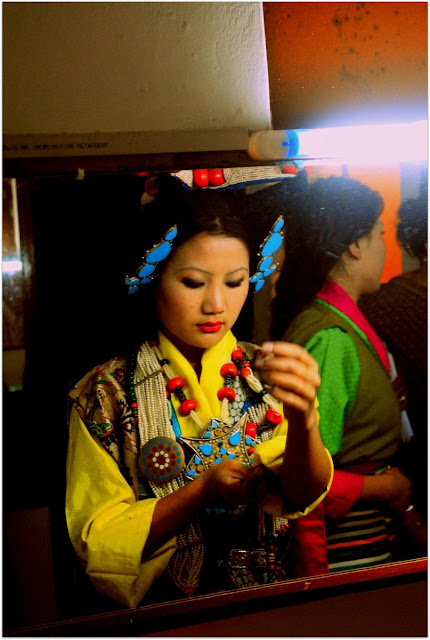 |
| Tibetan women wearing a chupa |
 | ||
| Tibetan women wearing a chupa |
 |
| Tibetan women wearing a chupa |
Tibetan costume ideally depends on the geographic area and the economic status. In cold northern Tibet, herdsmen usually wear fur robes whereas in Shannan prefecture where the climate is warmer, farmers wear tweed (a kind of wool produced in Tibetan rural areas). People in Lhasa wear silk clothing in summer and fur robes in winter.
The Tibetan costumes selling in shops nowadays are simpler and sleeker and made of different fabric and style compared to the traditional ones.
Interview
We interviewed Mr. Samten Dhondup, an opera teacher at the Tibetan Institute of Performing Arts (TIPA) about the costumes in Tibet during our visit to McLeodganj.
I am still editing and refining the interview video & hence will take some time to share. Meanwhile here is an extract of the interview.
 |
 |
According to him the styles, colors, motifs & patterns have changed a lot recently. Clothing of Tibet & its neighboring countries such as Mongolia & China are highly influenced by each other.
Tibet has taken the best things from its neighboring countries, he says. Food is influenced by China, clothing by Mongolia and religion (Buddhism) comes from India.
In Tibet, the fabric which is mainly used is made of sheep wool. The colors initially were only black and white. It was only later that people of high ranks traveled to India and got influenced by colors and started to use them. Now we see almost every color in Tibetan costumes.
Secondary Research
I was doing some secondary research over the internet today and this is what I found on http://english.chinatibetnews.com/Culture/2012-07/17/content_1015921.htm regarding the changes in Tibetan costumes local residents wear in Lhasa. Here is an extract:
Nowadays, the Tibetan costumes selling in shops are simpler and prettier, greatly changed in fabric and style compared with traditional ones.
"In fact, I feel that the style of male costume hasn't changed much, but that of female is tending to be more fashionable with a variety of fabrics and patterns." said Tsering Lhamo, a costume designer in Tibet Music and Dance Troupe.
Over the past decades, the most remarkable change of Tibetan costumes is color, said Tsering Lhamo, who has worked as a designer for over 20 years and has designed numerous theater costumes.
In the 1990s, the local residents in Lhasa wore costumes with simple color such as dark blue or brown, but now their Tibetan costumes are more colorful and beautiful.
The styles have changed much as well.
In the past, a suit of Tibetan costume was loose and long, and usually had a belt in the middle. A tailoring innovation occurred 30 years ago seperated the costume into two parts, making the top of costume fit well and the bottom still a comfortable skirt.
Visit to local tailors & dressmakers
In the main market in Bir we stopped by some local tailors' shops and saw some daily-wear chupas, construction details, etc.
The female chupa is a long, ankle-length dress made out of a variety of fabrics, and underneath it, one wears something called a woon-juk, which is an open shirt that is folded up into the chupa.
 |
| The Shirt or Woon-juk |
 |
| A modern Chupa. Its meant to be a little longer |
 |
| Add caption |
 | ||
The striped apron is worn only by married women
|
 |
| Still from a folk dance performance wherein the women have worn the colorful aprons |
 |
| Still from a folk dance performance wherein the women have worn the colorful aprons |
 |
| A local tailors shop in Bir |
 |
| Clothes for the Buddhist Monks in a local tailors shop in Bir |
.JPG)



.JPG)








































